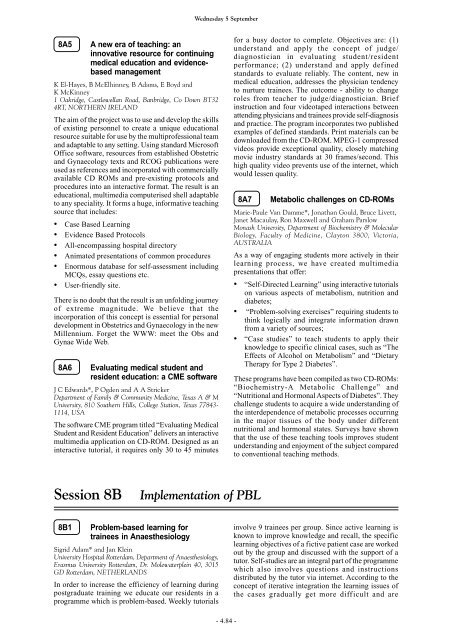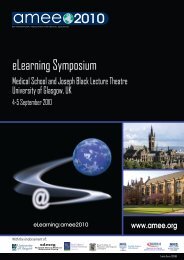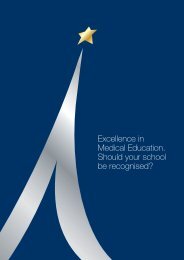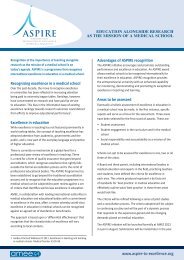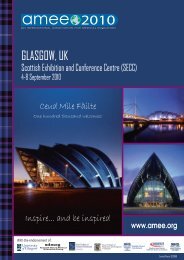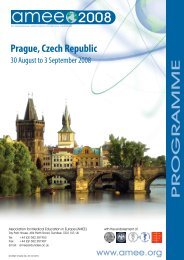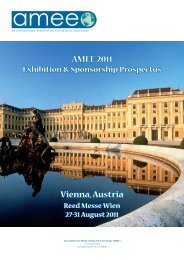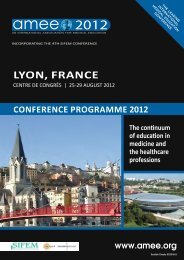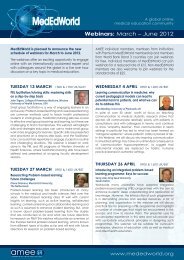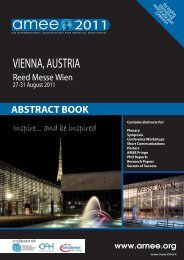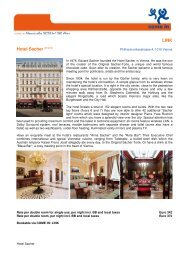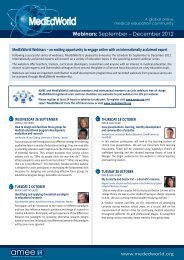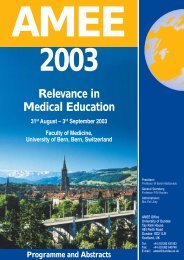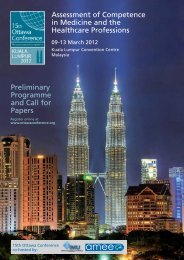AMEE Berlin 2002 Programme
AMEE Berlin 2002 Programme
AMEE Berlin 2002 Programme
Create successful ePaper yourself
Turn your PDF publications into a flip-book with our unique Google optimized e-Paper software.
8A5 A new era of teaching: an<br />
innovative resource for continuing<br />
medical education and evidencebased<br />
management<br />
K El-Hayes, B McElhinney, B Adams, E Boyd and<br />
K McKinney<br />
1 Oakridge, Castlewellan Road, Banbridge, Co Down BT32<br />
4RT, NORTHERN IRELAND<br />
The aim of the project was to use and develop the skills<br />
of existing personnel to create a unique educational<br />
resource suitable for use by the multiprofessional team<br />
and adaptable to any setting. Using standard Microsoft<br />
Office software, resources from established Obstetric<br />
and Gynaecology texts and RCOG publications were<br />
used as references and incorporated with commercially<br />
available CD ROMs and pre-existing protocols and<br />
procedures into an interactive format. The result is an<br />
educational, multimedia computerised shell adaptable<br />
to any speciality. It forms a huge, informative teaching<br />
source that includes:<br />
• Case Based Learning<br />
• Evidence Based Protocols<br />
• All-encompassing hospital directory<br />
• Animated presentations of common procedures<br />
• Enormous database for self-assessment including<br />
MCQs, essay questions etc.<br />
• User-friendly site.<br />
There is no doubt that the result is an unfolding journey<br />
of extreme magnitude. We believe that the<br />
incorporation of this concept is essential for personal<br />
development in Obstetrics and Gynaecology in the new<br />
Millennium. Forget the WWW: meet the Obs and<br />
Gynae Wide Web.<br />
8A6 Evaluating medical student and<br />
resident education: a CME software<br />
J C Edwards*, P Ogden and A A Stricker<br />
Department of Family & Community Medicine, Texas A & M<br />
University, 810 Southern Hills, College Station, Texas 77843-<br />
1114, USA<br />
The software CME program titled “Evaluating Medical<br />
Student and Resident Education” delivers an interactive<br />
multimedia application on CD-ROM. Designed as an<br />
interactive tutorial, it requires only 30 to 45 minutes<br />
Wednesday 5 September<br />
Session 8B Implementation of PBL<br />
8B1 Problem-based learning for<br />
trainees in Anaesthesiology<br />
Sigrid Adam* and Jan Klein<br />
University Hospital Rotterdam, Department of Anaesthesiology,<br />
Erasmus University Rotterdam, Dr. Molewaterplein 40, 3015<br />
GD Rotterdam, NETHERLANDS<br />
In order to increase the efficiency of learning during<br />
postgraduate training we educate our residents in a<br />
programme which is problem-based. Weekly tutorials<br />
- 4.84 -<br />
for a busy doctor to complete. Objectives are: (1)<br />
understand and apply the concept of judge/<br />
diagnostician in evaluating student/resident<br />
performance; (2) understand and apply defined<br />
standards to evaluate reliably. The content, new in<br />
medical education, addresses the physician tendency<br />
to nurture trainees. The outcome - ability to change<br />
roles from teacher to judge/diagnostician. Brief<br />
instruction and four videotaped interactions between<br />
attending physicians and trainees provide self-diagnosis<br />
and practice. The program incorporates two published<br />
examples of defined standards. Print materials can be<br />
downloaded from the CD-ROM. MPEG-1 compressed<br />
videos provide exceptional quality, closely matching<br />
movie industry standards at 30 frames/second. This<br />
high quality video prevents use of the internet, which<br />
would lessen quality.<br />
8A7 Metabolic challenges on CD-ROMs<br />
Marie-Paule Van Damme*, Jonathan Gould, Bruce Livett,<br />
Janet Macaulay, Ron Maxwell and Graham Parslow<br />
Monash University, Department of Biochemistry & Molecular<br />
Biology, Faculty of Medicine, Clayton 3800, Victoria,<br />
AUSTRALIA<br />
As a way of engaging students more actively in their<br />
learning process, we have created multimedia<br />
presentations that offer:<br />
• “Self-Directed Learning” using interactive tutorials<br />
on various aspects of metabolism, nutrition and<br />
diabetes;<br />
• “Problem-solving exercises” requiring students to<br />
think logically and integrate information drawn<br />
from a variety of sources;<br />
• “Case studies” to teach students to apply their<br />
knowledge to specific clinical cases, such as “The<br />
Effects of Alcohol on Metabolism” and “Dietary<br />
Therapy for Type 2 Diabetes”.<br />
These programs have been compiled as two CD-ROMs:<br />
“Biochemistry-A Metabolic Challenge” and<br />
“Nutritional and Hormonal Aspects of Diabetes”. They<br />
challenge students to acquire a wide understanding of<br />
the interdependence of metabolic processes occurring<br />
in the major tissues of the body under different<br />
nutritional and hormonal states. Surveys have shown<br />
that the use of these teaching tools improves student<br />
understanding and enjoyment of the subject compared<br />
to conventional teaching methods.<br />
involve 9 trainees per group. Since active learning is<br />
known to improve knowledge and recall, the specific<br />
learning objectives of a fictive patient case are worked<br />
out by the group and discussed with the support of a<br />
tutor. Self-studies are an integral part of the programme<br />
which also involves questions and instructions<br />
distributed by the tutor via internet. According to the<br />
concept of iterative integration the learning issues of<br />
the cases gradually get more difficult and are


